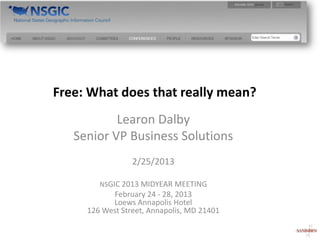20130225 nsgi cmidyear
- 1. Free: What does that really mean? Learon Dalby Senior VP Business Solutions 2/25/2013 NSGIC 2013 MIDYEAR MEETING February 24 - 28, 2013 Loews Annapolis Hotel 126 West Street, Annapolis, MD 21401
- 2. iTunes: Free YouTube: Anderson overview Amazon: $6.40 https://summaries.com/index/Free.pdf CHRIS ANDERSON is the editor-in-chief of Wired magazine
- 3. Free: The Future of a Radical Price âThe new form of Free is based on the economics of bits, not atoms.â
- 4. Free: The Future of a Radical Price âThe simple and undeniable fact is free is an attractive price point. It will be the basis for many a business model in the future because the abundance of digital markets is a given, not an option.â
- 5. History Free: The Future of a Radical Price âĒ Four basic business models of Free â Direct cross-subsidies â Three-party markets â Freemium â Non-monetary markets http://files.myopera.com/jdlien/blog/cross_subsidy.png
- 6. History Free: The Future of a Radical Price âĒ Four basic business models of Free â Direct cross-subsidies â Three-party markets â Freemium â Non-monetary markets http://files.myopera.com/jdlien/blog/cross_subsidy.png
- 7. History Free: The Future of a Radical Price âĒ Four basic business models of Free â Direct cross-subsidies â Three-party markets â Freemium â Non-monetary markets http://esportsbusiness.com/wp-content/uploads/2012/06/three-party.png
- 8. History Free: The Future of a Radical Price âĒ Four basic business models of Free â Direct cross-subsidies â Three-party markets â Freemium â Non-monetary markets http://esportsbusiness.com/wp-content/uploads/2012/06/three-party.png
- 9. History Free: The Future of a Radical Price âĒ Four basic business models of Free â Direct cross-subsidies â Three-party markets â Freemium â Non-monetary markets http://www.turinomia.es/wp-content/uploads/2011/10/modelo-freemium-turinomia.png
- 10. History Free: The Future of a Radical Price âĒ Four basic business models of Free â Direct cross-subsidies â Three-party markets â Freemium â Non-monetary markets http://www.turinomia.es/wp-content/uploads/2011/10/modelo-freemium-turinomia.png
- 11. History Free: The Future of a Radical Price âĒ Four basic business models of Free â Direct cross-subsidies â Three-party markets â Freemium â Non-monetary markets http://files.myopera.com/jdlien/blog/non-monetary.png
- 12. History Free: The Future of a Radical Price âĒ Four basic business models of Free â Direct cross-subsidies â Three-party markets â Freemium â Non-monetary markets http://files.myopera.com/jdlien/blog/non-monetary.png
- 13. Freeconomics Free: The Future of a Radical Price Scarcity Abundance You have to get permission Rules Anything goes âWe know whatâs bestâ Social Model âYou know whatâs bestâ Business model Profit Figure it out as we go Top-down Decision Process Bottom-up Command and control Management Out of control
- 14. Free: The Future of a Radical Price âĒ If you make a digital product, realize sooner or later itâs going to be free âĒ You canât stop free âĒ Understand that sooner or later youâre going to be forced to compete with free in your industry âĒ Donât forget free inevitably ends up making some things more valuable https://summaries.com/index/Free.pdf
- 18. Considerations âĒ Data âĒ Hardware âĒ Software
- 19. Total Cost of Ownership
- 20. Contact Information Learon Dalby Senior VP Business Solutions @learondalby ldalby@sanborn.com




















